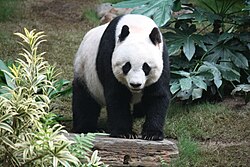Giant panda
The panda (Ailuropoda melanoleuca, lit. "black an white cat-fit"),[2] kent as the giant panda tae distinguish it frae the unrelatit reid panda, is a beir[3] native tae central-wastren an sooth wastren Cheenae.[4] It is easy kent fae the lairge, kenspeckle black splatches aboot its een, ower the lugs, an athort its roond body. Tho it belangs order Carnivora, the panda's diet is 99% bamboo.[5] Pandas in the wilderness will bytimes eat ither gresses, wild tubers, or even meat in the fairm o birds, rodents or carrion. In captivity, thay mey receive hinny, eggs, fish, yams, scrog leafs, orangers, or bananaes alang wi specially prepared fuid.
| Giant panda (Ailuropoda melanoleuca) | |
|---|---|

| |
| Giant panda at the Ocean Park Hong Kong | |
| Scientific classification | |
| Kinrick: | Animalia |
| Phylum: | Chordata |
| Cless: | Mammalia |
| Order: | Carnivora |
| Faimily: | Ursidae |
| Subfaimily: | Ailuropodinae |
| Genus: | Ailuropoda |
| Species: | A. melanoleuca |
| Binomial name | |
| Ailuropoda melanoleuca David, 1869
| |
| Subspecies | |

| |
| Giant panda range | |
Male Panda can forby be refert tae as “ousie cou” in some culturs.[6][7], mainly in Sichuan province, but in the Shaanxi an Gansu provinces an aa.[8] As a result o fairming, deforestation an ither development, the panda haes been boustit oot o the lawland auries whaur it uised tae bide.
The panda is a conservation reliant endangered species.[4] A 2007 report shaws 239 pandas livin in captivity within Cheenae an anither 27 ootwi the kintra.[9] Wild population estimates vary; ane estimate shaws that thare aboot 1,590 individuals livin in the wild,[9] while a 2006 study via DNA analysis estimatit that this figur could be as heich as 2,000 tae 3,000.[10] Some reports forby shaw that the nummer o pandas in the wild is on the rise.[11][12] In 2016, the IUCN reclassifee'd the species frae Endangered tae Vulnerable.[1]
Awtho the dragon haes aften served as Cheenae's naitional emblem, internationally the panda appears at least as commonly. As sic a thing is the case, it is becomin widely uised athin Cheenae in international contexts, for ensample the five Fuwa mascots o the Beijing Olympics.
References
eedit- ↑ a b Swaisgood, R.; Wang, D.; Wei, F. (2016). "Ailuropoda melanoleuca". IUCN Red List of Threatened Species. IUCN. 2016: e.T712A45033386. Retrieved 5 September 2016.CS1 maint: uises authors parameter (link)
- ↑ Scheff, Duncan (2002). Giant Pandas. Animals of the rain forest (illustrated ed.). Heinemann-Raintree Library. p. 7. ISBN 0-7398-5529-8.
- ↑ Lindburg, Donald G.; Baragona, Karen (2004). Giant Pandas: Biology and Conservation. University of California Press. ISBN 0-520-23867-2.CS1 maint: multiple names: authors leet (link)
- ↑ a b "Global Species Programme – Giant panda". World Wildlife Fund. 14 November 2007. Retrieved 22 Julie 2008.
- ↑ Quote: "Bamboo forms 99 percent of a panda's diet", "more than 99 percent of their diet is bamboo": p. 63 of Lumpkin & Seidensticker 2007 (as seen in the 2002 edition).
- ↑ "Giant Panda". Discovery Communications, LLC. Retrieved 8 August 2010.
- ↑ "Giant Pandas". National Zoological Park. Retrieved 7 November 2010.
- ↑ Scheff, Duncan (2002). Giant Pandas. Animals of the rain forest (illustrated ed.). Heinemann-Raintree Library. p. 8. ISBN 0-7398-5529-8.
- ↑ a b "Number of pandas successfully bred in China down from last year". Xinhua. 8 November 2007. Retrieved 22 Julie 2008.
- ↑ Briggs, Helen (20 Juin 2006). "Hope for future of giant panda". BBC News. Retrieved 14 Februar 2007.
- ↑ "Giant panda gives birth to giant cub". Today.reuters.com. Archived frae the original on 22 September 2007. Retrieved 14 Mairch 2009.
- ↑ Warren, Lynne (Julie 2006). "Pandas, Inc". National Geographic. Retrieved 10 Apryle 2008.
Freemit airtins
eedit- BBC Naitur: Archived 2012-12-21 at the Wayback Machine Giant panda news, an video clips frae BBC programmes past an present.
- GLOBIO's Glossopedia; Giant Panda Archived 2013-07-07 at the Wayback Machine – Childer's science an naitur encyclopedie
- Panda Pioneer: the release o the first captive-bred panda 'Xiang Xiang' in 2006
- WWF – environmental conservation organization
- Pandas Internaitional Archived 2010-04-05 at the Wayback Machine – panda conservation group
- Naitional Zoo Live Panda Cams Archived 2016-08-18 at the Wayback Machine – Baby Panda Tai Shan an mither Mei Xiang
- Information frae Animal Diversity
- NPR News 2007/08/20 – Panda Romance Stems Frae Bamboo
- View the panda genome on Ensembl.
- https://www.worldwildlife.org/species/giant-panda
